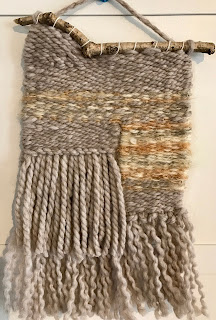Finding the shuttle that's 'just right'
 |
| Schacht end-feed shuttle w/tension device |
 |
| Above: AVL tensioned end feed shuttle. ca.1981 w/pirns Below: Boat shuttle w/paper quill |
 |
| Above: Bluster Bay end-feed shuttle w/hooks and eye Below: Boat shuttle with bobbin |
I was using two colors for some of the towels and that gave me a good opportunity to evaluate the shuttles against each other.
Ideally, I'd want two shuttles of the same weight and balance for a project--and the end-feed shuttles I had were too different to pair. So, I tried using a traditional boat shuttle and bobbin with the Bluster Bay, only to be reminded how much I hated the rolling bobbins that either pay out excess weft or hold onto it so tightly it pulls the selvedge too often. A paper quill was better, but couldn't replicate the selvedges of the Bluster Bay.
I longed for the 'just right' end-feed shuttle.
Path to purchase
I had purchased my first end-feed shuttle--the Bluster Bay--at a conference on recommendations from others, but hadn't really researched available products. I love the shuttle, but cost is always a consideration. Much as I love working with the elegant shuttle, the cost for shuttle with a metal tensioning device is one-third to one-half again the cost of other brands.I needed more information. I weighed my shuttles--with and without pirns--and collected specifications for end-feed shuttles with metal tensioning devices on the market. Then I consulted with weavers on Weavolution, where there had been a lengthy discussion a few years ago on the topic.
 |
| Schacht end-feed tensioning device, detail |
I have been using my new shuttle and I love it. It's not as beautiful in the hand, but i's a snap to thread (no hook needed!) and the metal tensioning pads are easily adjustable.
No, I don't have a matched pair, but the Bluster Bay and the Schacht work pretty well together. At least for now.
And now I have only myself to blame if my selvedges are less than nice.
Here are some specs used in my decision-making process.
| Specifications |
Ahrehns & Violette
(Chico, California)
|
Bluster Bay
(Sandpoint, Idaho)
|
Schacht
(Boulder, Colorado)
|
| Length | 15 inches | 11 inches | 12 inches |
| Type pirn | Wood | Cardboard | Wood |
| Weight (with/without pirn) | 7.8 oz/5.8 oz | 3.7 oz/3.8 oz | 4.8 oz/5.4 oz |
| Tension type | Metal tensioning pads | Hook and Eye | Metal tensioning pads |
Note: End-feed shuttles require pirns to match.



